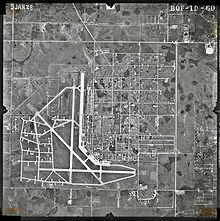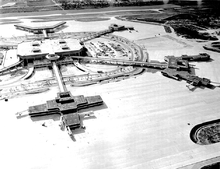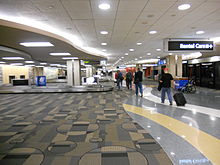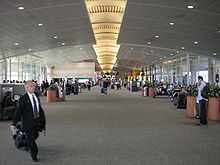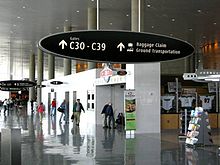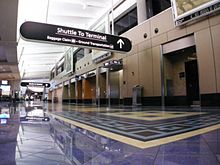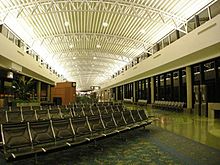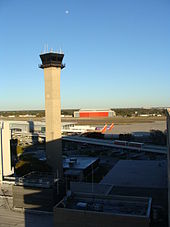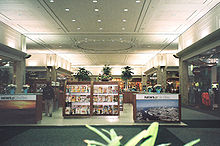- Tampa International Airport
-
Tampa International Airport 
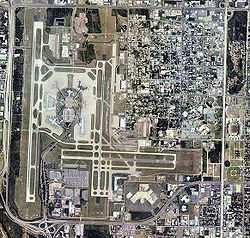
USGS aerial photo - 10 May 2002 IATA: TPA – ICAO: KTPA – FAA LID: TPA Location of TPA Summary Airport type Public Owner Hillsborough County Aviation Authority Serves Tampa, Florida Elevation AMSL 26 ft / 8 m Coordinates 27°58′32″N 082°32′0″W / 27.97556°N 82.533333°WCoordinates: 27°58′32″N 082°32′0″W / 27.97556°N 82.533333°W Website Runways Direction Length Surface ft m 10/28 6,999 2,133 Asphalt/Concrete 19L/1R 8,300 2,530 Asphalt/Concrete 19R/1L 11,002 3,353 Concrete Helipads Number Length Surface ft m H1 100 30 Asphalt Statistics (2010) Total Passengers 16,645,765 Aircraft operations 279,183 (2,008) Based aircraft 90 (2,008) Source: Federal Aviation Administration[1]  FAA diagram of Tampa International Airport (TPA)
FAA diagram of Tampa International Airport (TPA)
Tampa International Airport (IATA: TPA, ICAO: KTPA, FAA LID: TPA) is a major public airport located six nautical miles (11 km) west of the central business district of Tampa, in Hillsborough County, Florida, United States. This airport is publicly owned by Hillsborough County Aviation Authority.[1] It serves the Tampa Bay Area and has been widely praised for its attractive architecture and Landside/Airside design of a central terminal ("landside") connected by people movers to satellite gates ("airsides"), a pioneering concept when initially designed in the late 1960s. The airport was known as Drew Field Municipal Airport until 1952.[2]
Tampa International Airport currently serves as a main hub for Gulfstream International Airlines under the Continental Connection name. It is also the main aircraft and maintenance base for World Airways and North American Airlines.[3] Today, Southwest Airlines carries the largest share of TPA passengers, operating a peak-season schedule of over 80 daily flights.[4] The airport presently serves 71 non-stop destinations, including international service to Canada, Mexico, Switzerland, the United Kingdom, and to destinations throughout the Caribbean. The airport handled 16,645,765 passengers in 2010, making it the 30th busiest airport by passenger movements[5] in North America. International Plaza and Bay Street is adjacent to the airport.
Contents
- 1 History
- 2 Terminal, airlines and destinations
- 3 TPA Airport today
- 4 Accidents and incidents
- 5 See also
- 6 References
- 7 External links
History
Tampa Bay was the birthplace of commercial airline service, when pioneer aviator Tony Jannus flew the inaugural flight of the St. Petersburg-Tampa Airboat Line on January 1, 1914, from St. Petersburg, Florida, to Tampa using a Benoist Flying Boat — the first scheduled commercial airline flight in the world using a heavier-than-air airplane.[6]
Drew Field
In 1928 the city completed the 160-acre (65 ha) Drew Field six miles (10 km) west of Downtown Tampa. The more popular Peter O. Knight Airport was opened on Davis Islands near Downtown Tampa in 1935, where both Eastern and National Airlines operated until 1946.
The United States Army Air Force took over Drew Field during World War II and expanded and modernized the airport. The airfield was used by Third Air Force and renamed it Drew Army Airfield. Third Air Force used it as a training center by 120,000 combat air crews and flew antisubmarine patrols from the airfield. There was one accident in 1943 that killed five fliers.[7] Despite this, Drew Field set a safety record for the Third Air Force in 1945 after 100,000 flying hours had been completed over a period of 10 months without a fatal incident. The aircraft operated included the B-17, C-47, AT-6, B-25, and others.[8]
Tampa International Airport
After the hostilities, Eastern and National Airlines moved to Drew Field, the Peter O. Knight Airport being too small for the new Douglas DC-4, DC-6 and Lockheed Constellation prop-liners that were entering service. During this period the airlines used the former Base Operations Building which was converted into a terminal.
Trans Canada Airlines inaugurated international flights in 1950 and Drew Field was renamed Tampa International Airport. The airport's second terminal opened in 1952 near the intersection of Columbus Drive and West Shore Blvd.
The April 1957 OAG shows 30 departures a day on Eastern: nonstops to MDW-YIP-CLE-IDL-BOS, seven nonstops to Atlanta and 18 within Florida. National had 26 departures including seven nonstops beyond Florida (to HOU-HAV-DCA-IDL and three to MSY). Trans-Eastern had 12 departures and Mackey had two DC-3s, none nonstop beyond Florida. Trans-Canada had thirteen nonstops a week to Toronto or Montreal.
The 1952 terminal, built for three airlines, was swamped after the Civil Aeronautics Board granted Capital, Delta, Northeast, Northwest and Trans World Airlines authority to fly to Tampa in the late 1950s. An annex was built east of the terminal to accommodate the new carriers.
Turbine-powered flights began in 1959 on Eastern Air Lines' Lockheed L-188 Electra; the following year National, Eastern and Delta Airlines began jet flights with the Douglas DC-8 jetliner. Weekly flights to Mexico City began in 1961 on Pan American.
Congestion became a serious problem at the 1952 terminal when the airlines began to replace their piston airliners with larger jets; the terminal was again expanded to temporarily handle the traffic.
The 1971 Terminal
During the early 1960s, the aviation authority began making plans to build a replacement terminal in an undeveloped site at the airport. Airport leaders chose the Landside/Airside design in 1965 after a careful study of different types of terminals.
Construction on the new terminal began in 1968 between the airport's parallel jet-capable runways. When completed in 1971 the new jetport was highly praised by the press. Prior to its official April 15 opening, 60,000 people toured the new facility during a two day open house event. National Airlines Flight 36 from Los Angeles was the first to arrive at the terminal. After touching down at 05:26 am the jet taxied to Airside E to disembark its passengers.
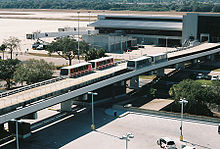 The people mover system (Airside E, right)
The people mover system (Airside E, right)
The airport's people mover system was the first such system in the world. The original eight trains were built by Westinghouse.
The 227-foot (69 m) tall Air Traffic Control Tower became operational on July 15, 1972 and at the time was the tallest in the United States. The Host/Marriott Airport Hotel with its revolving rooftop restaurant got plenty of attention when it opened its doors on December 1973. The building's features include triple-paned windows and sound-proof guest rooms.
Northwest Airlines and National Airlines brought the Jumbo Jet to the airport late in 1971 with the introduction of the Boeing 747 and McDonnell Douglas DC-10. This was followed by the introduction of the Lockheed Tristar a year later by Eastern Air Lines. National Airlines began trans Atlantic DC-10 service to Amsterdam and Paris in 1977. In 1991, Airside B closed following the demise of Eastern Airlines.
During the following decades, the airport was expanded and improved to handle more traffic and additional airlines. In 1996, Airsides C and D were remodeled. The interiors of both satellites were refurbished and the original Westinghouse shuttles were replaced with Bombardier Innovia APM 100 trains. During this time, all the airlines from both facilities were housed in Airside E. Upon completion of the renovations, the airlines returned to their original locations and Airside E was closed for good. The Landside Terminal was also remodeled numerous times during the 1980s and 1990s.
Both Delta Air Lines and US Airways opened maintenance bases at the airport to service their growing fleets. However, both bases closed following the September 11 terrorist attacks and the airline struggles that ensued. Alabama based Pemco World Air Services currently occupies the former US Airways hangar performing MRO (maintenance, repair, overhaul) services for the Southwest Airlines 737 fleet and the United Airlines 747,767 and 777 fleets.[9] On April 1, 2010, a press release announced that a lease agreement was reached to allow Pemco to lease the second hangar formerly used by Delta Air Lines. Pemco expects to be operational by September 1, 2010 and will then occupy both maintenance facilities at the airport.[10]
Terminal, airlines and destinations
Tampa International Airport's Landside/Airside terminal was the first of its type in the world.[11] There is a central Landside Terminal where baggage and ticketing functions take place. The Landside Terminal is surrounded by four Airside satellites where airliner embarkment and disembarkment occur. Each Airside is connected to the Landside Terminal via an elevated automated people mover (APM) system which employs 16 Bombardier Innovia APM 100 Shuttle Cars. TPA was the first airport in the world to deploy a fully automated, driver-less people mover system and is host to Bombardier Transportation's longest-running APM system. The terminal was originally designed to limit the walking distance between the automobile and airliner to 700 feet (210 m); today, it has increased to about 1,000 feet (300 m), due mostly in part to the larger, more modern airside buildings which have replaced the original, smaller structures. The future of the Airport is certain to see continued growth and success. Many plans have been set in motion to expand the airport and its facilities as the Tampa Bay area continues to thrive.
Airsides
Today, there are four active airsides (A, C, E and F) with 62 gates. All were constructed after 1985 and all airsides include a food court and gift shop, and outdoor smoking patios. Airsides E[12] and F[13] contain duty free shops in addition to the regular gift shops to serve passengers arriving or departing on international flights. As of 2011, the security screening area in each airside is equipped with Advanced Imaging Technology (AIT) walk-thru detection machines, made by L3 Communications, whose devices use Millimeter wave scanner#Possible health effects millimeter wave technology and not backscatter radiation. A brief description of each airside and the airlines they occupy are listed below, including the major cities/hubs that each airline serves from TPA.
- Airside A
- includes gates 1-12 and 14-18
- it was opened on March 16, 1995 and was designed by Continental Airlines
- it features a space designated for use by an airline lounge (intended to be a Continental Airlines Presidents Club), however it is unused
- Airside C
- includes gates 30-45
- it was the last airside to be demolished and rebuilt from the ground up; it was designed by arhcitect Alberto Alfonso and reopened to passengers on April 19, 2005
- Airside E
- includes gates 62-75
- it was the first airside to be demolished and rebuilt
- the current fourteen-gate facility was designed for Delta Air Lines and was dedicated and opened to passengers on October 15, 2002
- the facility includes one airline lounge: the Delta Air Lines "Sky Club"
- Airside F
- includes gates 76-90
- it was opened on November 4, 1987 and was designed for international flights
- the facility includes two airline lounges: the US Airways' Club and the International Club which is used by British Airways passengers
- the customs/immigration center is located on level 1
Airlines and destinations
Airlines Destinations Airside Air Canada Toronto-Pearson
Seasonal: Halifax, Montréal-TrudeauE AirTran Airways Akron/Canton, Atlanta, Baltimore, Dayton, Grand Rapids, Indianapolis, Key West, Milwaukee, Rochester (NY), San Juan
Seasonal: Asheville [ends Janurary 6, 2012], Flint, PittsburghC American Airlines Chicago-O'Hare, Dallas/Fort Worth, Miami, New York-JFK
Charter: Havana, Holguin [Begins November 22][14]F British Airways London-Gatwick F Cayman Airways Grand Cayman F Continental Airlines Cleveland, Houston-Intercontinental, Newark A Continental Connection operated by Gulfstream International Airlines Key West, Pensacola, Tallahassee
Seasonal: Fort LauderdaleA Continental Express operated by ExpressJet Airlines Seasonal: Cleveland, Houston-Intercontinental A Delta Air Lines Atlanta, Cincinnati/Northern Kentucky, Detroit, Los Angeles, Memphis, Minneapolis/St. Paul, New York-JFK, New York-LaGuardia
Seasonal: CancunE Delta Connection operated by Atlantic Southeast Airlines Miami
Seasonal: MemphisE Delta Connection operated by Comair Miami, Raleigh/Durham E Delta Connection operated by Compass Airlines Washington-National E Delta Connection operated by Mesaba Airlines Seasonal: Memphis E Delta Connection operated by Shuttle America New York-LaGuardia, Washington-National E Edelweiss Air Zurich [begins May 25, 2012][15] F Frontier Airlines Seasonal: Denver[16] A Frontier Airlines operated by Republic Airlines [begins December 15] Seasonal: Des Moines, Omaha A JetBlue Airways Boston, New York-JFK, Newark, San Juan, White Plains A North American Airlines
Maintenance BaseGlobal Aviation Facitlity/Pemco/Hardstand/FedEx 4 Southwest Airlines Albany, Austin, Baltimore, Birmingham (AL), Buffalo, Chicago-Midway, Columbus (OH), Denver, Fort Lauderdale, Hartford, Houston-Hobby, Indianapolis, Jacksonville, Kansas City, Las Vegas, Long Island/Islip, Louisville, Manchester (NH), Nashville, New Orleans, Norfolk, Philadelphia, Phoenix, Pittsburgh, Providence, Raleigh/Durham, St. Louis, San Antonio, West Palm Beach
Seasonal: MilwaukeeC Spirit Airlines Atlantic City, Detroit, Fort Lauderdale A Sky King Charter: Havana[17] F Sun Country Airlines Minneapolis/St. Paul E United Airlines Chicago-O'Hare, Denver, Washington-Dulles A US Airways Charlotte, Philadelphia, Phoenix, Washington-National F US Airways Express operated by Republic Airlines Seasonal: Washington-National F WestJet Toronto-Pearson
Seasonal: Halifax, OttawaF World Airways
Maintenance BaseGlobal Aviation Facitlity/Pemco/Hardstand/FedEx 4 Top destinations
Busiest Domestic Routes from Tampa International Airport (June 2010 - May 2011)[18] Rank City Passengers Carriers 1  Atlanta, GA
Atlanta, GA905,000 AirTran, Delta 2  Charlotte, NC
Charlotte, NC367,000 US Airways 3  Philadelphia, PA
Philadelphia, PA351,000 Southwest, US Airways 4  Baltimore, MD
Baltimore, MD312,000 AirTran, Southwest 5  Dallas/Fort Worth, TX
Dallas/Fort Worth, TX307,000 American 6  Newark, NJ
Newark, NJ305,000 Continental, JetBlue 7  New York, NY (JFK)
New York, NY (JFK)292,000 American, Delta, JetBlue 8  Detroit, MI
Detroit, MI291,000 Delta, Spirit 9  Chicago, IL (ORD)
Chicago, IL (ORD)254,000 American, United 10  Fort Lauderdale, FL
Fort Lauderdale, FL251,000 Continental, Southwest, Spirit Cargo
Cargo Airline Destination FedEx Express Memphis, Newark, Indianapolis Paragon AirExpress Birmingham (AL) Original airsides
The original TPA airsides were designed in the mid 1960s as four identical facilities. The concept was later scrapped for unknown reasons and the facilities were eventually built around the requirements of their then primary tenant airlines. Thus creating the four dissimilar facilities that stood from their opening in 1971 to 2000. Each airside building was three stories tall and included a minimum of ten gates, a cocktail lounge, snack bar, and gift shop. Each airside was maintained by the airline for which it was built until 1999. All of the facilities (except Airside B) were renovated in the early/mid 1990s but received no further modifications during their life span. All 4 of the original airside buildings have been demolished and either re-built or the space re-used as noted below.
Below is a brief description of the four original airsides and the airlines that occupied them throughout the years. The bolded airlines indicate the primary (anchor) tenants for each facility.
- Airside B - former Gates 19-30 (1971–1991)
- Airside B was a twelve-gate facility that was designed by Eastern Airlines and was the first original airside to shut down. The closure was the direct result of Eastern's cessation of operations in 1991. There were preliminary plans to renovate and revive the airside during the early 1990s, but efforts failed and planning for Airside A commenced immediately in 1992. The airside was not rebuilt due to a lack of overnight parking for aircraft, the facility's close proximity to one of TPA's runways, and the need for a separate automated baggage sorting facility for Airside A (since Airside A could not accommodate a built-in facility due to its pre-2001 construction), and was eventually demolished in 2003.
Today an overnight aircraft hardstand and an automated baggage sorting facility for Airside A sit on the former site. The site could also one day house an intermodal center that would allow passengers to connect to various mass transit options, including Tampa's proposed light rail system.
- Airside C - Gates 31-41
- Airside C was an eleven-gate facility designed by Delta Air Lines. The facility originally housed a customs/immigration center for arriving Air Canada and Pan Am international flights. The center was closed in 1987 and a Delta Crown Room was added. The airside was renovated (and its shuttles replaced) in 1996 but never received any further modification. By the late 1990s, Delta's presence in Airside C was dramatically increasing, and so was the congestion and lack of gate space. The airline soon requested HCAA to build a new facility for them. Airside E was deemed inactive by 1997 and its future quickly went up in the air. In 1998, it was decided that Airside E be demolished and rebuilt for Delta. After a brief halt in construction due to the September 11, 2001 terrorist attacks, the new Airside E opened in 2002 and Delta immediately moved in. After much debate by the HCAA about whether to demolish or renovate the aging facility, Airside C was then slated for demolition and replacement in 2003.
- Airside D - former Gates 46-55 (1971–2005)
- Airside D was the last of the original airsides to close. The facility was designed by Northwest Airlines and was originally without some jet-ways until government airline regulation ended in 1978. The airside was renovated in 1996 (and its original shuttles were replaced). Northwest moved to Airside A in 1999 and United moved to the rebuilt Airside E in 2002. Airside D closed in May 2005 and its remaining tenants (AirTran, JetBlue, and Spirit) were relocated to Airsides A and C. The facility was demolished in May 2007 and the site is currently used as a hard-stand for aircraft parking, but will eventually be used for the Control Tower and Ground Radar relocation in preparation for the new North Terminal facility. An 8-10 Gate replacement facility may be built down the road depending on capacity needs, but is not likely until 2020 or beyond.
- Airside E - Gates 61-70
- The original Airside E was designed by National Airlines and boasted a slightly different layout from the other airsides. Its boarding gates were on the third level (as opposed to the second level in the other airsides). This was due to the fact that the facility was designed specifically for the DC-10. The first level was open to allow tugs to drive right through. This was due to the airsides close proximity to the taxiway. Airside E housed National until its demise and takeover by Pan Am. Pan Am, in turn, occupied the facility until its own demise. Thereafter, the facility was renovated (in 1991) and Continental became its final major tenant. The facility was closed in 1995 after Continental's new terminal (Airside A) opened. The airside was demolished in 2000 and replaced by its current facility.
TPA Airport today
Today, TPA Airport handles about 16.6 million passengers per year [5]) and improvements currently in progress will increase capacity to 25-million passengers a year. The airport's car rental market is in the top five among all U.S. Airports. And the facility continues to receive consistent top-ranking reviews from numerous publications. In 2007 and 2008, Zagat Survey ranked TPA the "Best Overall U.S. Airport," while placing it second best overall in 2009 and 2010. In 2008 Condé Nast Traveler recognized TPA as the second-best airport in the world, just two-tenths of a point behind the first place winner. JD Power and Associates have also given TPA Airport consistently high customer satisfaction ratings over the years. Presently, the largest aircraft serving TPA is the Boeing 777. However, 747's are worked on at Pemco's new maintenance facility and are seen in Tampa occasionally.
At this time, new runway is being planned (17-35) to increase capacity in fair-weather conditions. In addition, a second Landside Airside Terminal will be built to the north of the current facility, allowing the airport to serve over 50-million passengers a year by 2025. Construction of this facility was originally slated to begin in 2010, with completion set to October 2015. However, the St. Petersburg Times reported on November 7, 2008 that the airport authority is no longer pursuing the original planned dates due to the current state of the US and global economies. The current struggle of the airline industry, including the recent merger by Delta and Northwest, has forced passenger levels to level off, and slowly decline at the airport. Additionally, with more possible airline mergers on the way, TPA Airport may not require drastic expansion for another five to six years. The revised start date of construction of the north terminal is now estimated at around 2015. According to the Tampa Tribune, passenger levels dropped by 14% in January 2009 [6]
Phase I of the economy parking garage was completed in November 2005.[19] Phase II of the economy garage opened ahead of schedule in November 2005, bringing a total of 5,600 parking spaces.[20]
Tampa International Airport covers an area of 3,300 acres (1,300 ha) at an elevation of 26 feet (8 m) above mean sea level. It has three runways: 10/28 is 6,999 by 150 feet (2,133 x 46 m) with an asphalt/concrete surface; 19L/1R is 8,300 by 150 feet (2,530 x 46 m) with an asphalt/concrete surface; 19R/1L is 11,002 by 150 feet (3,353 x 46 m) with a concrete surface.[1] On January 13, 2011 the runway designations changed due to a shift in the magnetic headings. 9/27 became 10/28, 18R/36L became 1L/19R, 18L/36R became 1R/19L.[21]
For the 12-month period ending May 30, 2008, the airport had 279,183 aircraft operations, an average of 764 per day: 85% scheduled commercial, 14% general aviation and <1% military. At that time there were 90 aircraft based at this airport: 66% jet, 19% single-engine, 3% multi-engine and 12% helicopter.[1]
In January, 2011, Rep. Kathy Castor announced that Tampa International Airport has been designated an official "entry/exit" point for travels to and from Cuba, allowing for Cuban-Americans to travel directly from Tampa to Cuba on chartered flights. Castor expects the TPA administration to recruit charter operators to establish service to Cuba over coming months as final regulatory clearance is granted.[22] On March 7, 2011, federal officials gave TIA the green light to begin charter flights to Cuba.[23]
Airport amenities
Airport conveniences that are free of charge include passenger paging, wireless Internet access, cell phone waiting lot with flight information, shuttle service from the economy garage, real-time flight information and travelers aid services. Other services include eateries located before passenger checkpoints, touch screen information kiosks, information about local events and outdoor smoking areas.
The logo
The logo represents the blue waters of Tampa Bay with a jetliner flying into a downtown Tampa sunset. It is known as the "Spirit of Flight". The jetliner was modelled after those once used for supersonic transport -- at the time the logo was created in the 1970s, it was during an era when it was thought that supersonic aircraft would replace conventional jets as a mode of air travel.[citation needed]
The color-coding system
Since its opening on April 15, 1971, Tampa International Airport has used a special color-coding system throughout the terminal complex. The Baggage Claim Areas and Ticket Counters are color-coded Blue and Red. Airlines are assigned a color depending on their location within the Landside Terminal Building. The airlines found in the south side of the terminal are color-coded blue. The carriers located in the north side are color coded red. The codes were also assigned names to assist color-blind patrons. The Blue side names are Neil Armstrong and Amelia Earhart. The Red side names are Igor Sikorsky and Chuck Yeager. The Long Term Parking Garage also uses the special color coding system. The four elevator cores have names and colors to make it easier for customers to remember where they've parked. Wright Brothers - Orange, Tony Jannus - Purple, Robert Goddard - Green and Charles Lindbergh - Brown. The Economy Parking Garage (EPG) is also split into two sections Purple and Gold. The newest phase, opened in time for the 2008 holiday season, will be Green and Orange. The EPG cores have no names at the present.
The Landside Terminal
The Landside Terminal was designed with convenience in mind. Express elevators and escalators keep passenger traffic moving smoothly, with few bottlenecks.
Level 1 (Baggage Claim) contains all inbound baggage facilities and baggage belts. The Blue Rental Car facility was relocated from its crammed Bag Claim location, to a consolidated facility beneath the long term parking garage in 2002. On November 15, 2006 a new Red Rental Car facility and garage opened adjacent to the Marriott.[24] In late 2008, renovation of the Baggage Claim began. Improvements include new baggage carousels and an inbound baggage screening system. This project was completed in 2010.
Level 2 (Ticketing) contains all ticketing/check-in functions. The level also contains a Charter desk reserved for flights that do not normally utilize TPA. The Ticketing area received a major renovation/expansion in 2002.
Level 3 (Transfer Level) includes the airside shuttle stations and a shopping area known as the Airport Galleria. The airport Marriott Hotel is adjacent to the main terminal. Tampa's facilities are almost entirely housed in the public access main terminal. The facilities are mostly operated and run by three airport retail companies - HMS Host, Stellar Partners, Bay Area Concessions and OSI Restaurant Partners.
- There are two food courts on level 3, operating on opposite sides of the building. The Galleria also features TGI Friday's, the first airport Carrabba's,[25] diverse shopping attractions, such as a Ron Jon Surf Shop, Brookstone and Harley-Davidson. There is also an outdoor smoking/observation patio located where the Airside B shuttle bay once stood.
- Level 3 has undergone numerous major renovations. The main building was renovated in 1997. Shuttle bay expansions were constructed in 1986 for Airside F, 1994 for Airside A, 2001 for Airside E, and 2004 for Airside C. Future expansion plans include a relocation of the shuttle bay for Airside E by 2012, and, if the plans for a light rail system in the Tampa Bay area come to fruition, a light rail station could be constructed at the current Observation Deck location. The airport also has plans on building a north terminal complex in addition to the existing complex by 2020.
Service building
When the airport opened its doors in 1971, the Service Building went into operation as well. It housed the very first Communications Center, Police dispatch, employee cafeteria and maintenance locker rooms. The building is located across from the Red Baggage and Ticketing levels. It was primarily intended to house mechanical equipment such as the chiller plant and electrical transformers. Since then it has been expanded to two levels which was in the original design in 1968. Today it houses the original facilities with the addition of offices, rental car counters, badging and a receptionist desk. The Police department/Lost & Found has a lobby on level two (ticketing level) for walk-in lost & found requests.
Parking facilities
Currently, over 20,000[26] parking spaces are available at the airport. These spaces are split between the Short Term Parking Garage, the Long Term Parking Garage, and the Economy Parking Garage. As of right now, there is an ongoing expansion of the Economy Parking Garages which is in its second phase of construction. Also, the SunPass Plus program, first introduced at Orlando International Airport, is being implemented at TPA in stages. In early 2009, the Economy Parking Garages began using the program, in which customers can use their SunPass transponders to pay for parking. The program was expanded to the Short & Long-Term garages during the summer of 2009. [7] In addition, TIA also provides "self-serve" lanes in which customers can pay with their credit card instead of waiting in line for the cash lanes.
Short term parking garage
Levels 4-9 of the Landside Terminal Building house the short term parking garage. The garage was built with the airport complex in 1971 for added passenger convenience. Originally three levels, the garage was expanded in 1982 to six levels and contains 3,612 spaces.
Long term parking garage
Long term parking was originally a large lot sitting on what is today, the present-day long term parking garage. The garage was built in several phases from 1990 to 1997 after increased passenger traffic swamped the parking lot beyond capacity. A monorail (situated on Level Five of the garage) connects passengers to and from the short term parking garage (Level Five) and the Landside Terminal. The garage can hold a total of 7,635 spaces on six levels.
Economy parking garage
On November 1, 2005 phase I-A of the garage opened to the public and then on May 19, 2006 phase I-B opened. The garage is 8,043 spaces large and is divided into two color-coded sections - purple and gold (yellow). There is also a surface lot and overflow lot for use during the holidays. A free shuttle service takes passengers to the terminal drop-off twenty-four hours a day. Construction began in early 2008 on phase II which will be an exact copy of the first phase.
Cell phone waiting lot
In an effort to decrease congestion within the Landside Terminal, particularly the baggage claim areas, a cell phone waiting lot was built alongside one of the remote overflow lots. It includes two large four panel flight status boards, showing real-time arrival information. This allows awaiting family members and friends of arriving passengers to wait in their vehicles until the passenger calls. Then the arriving passenger(s) can be picked up curbside at the Landside Terminal without creating curbside congestion problems. The lot has restrooms, WiFi, recorded CCTV surveillance and around-the-clock police patrols. Construction began in early 2008 to expand the cell phone waiting lot and was completed in November of that same year. The lot contains approximately 125 striped spaces.[citation needed]
Monorail
The monorail was installed in 1991 when the new long term parking garage was built and opened on December 16. It was the first of its kind in the world to include six driverless, electrically propelled cars that are completely computer controlled. The system was also the first to have active switches and it is monitored from the airport's communications center. There are four long term stations. The Monorail circles the long term parking garage and connects to the short term garage via an elevated bridge to stop at four additional stations. The Monorail is free to use and runs twenty-four hours a day except for a once-a-week maintenance shut-down in the overnight hours. Bombardier Transportation maintains the system by contract and the Aviation Authority owns it. THALES Rail Signalling Solutions Inc. won a contract in 2008 to completely upgrade the computer control system. The upgrade was implemented and tested for an entire year. The only visible change to passengers is the station graphics which show the position of each monorail car and display system status information.[27]
Future Intermodal Center
Plans are currently in the works for the construction of an intermodal facility located on airport premises. This would allow passengers to better connect to the number of proposed bus routes by both HART and PSTA.[28] In addition, a light rail system is being planned for the Tampa area, with a link to TPA Airport from Downtown Tampa and the WestShore district.[29]
North Terminal
A future north terminal will be built north of the existing facility and could be operational by 2020 depending on demand, although the exact time frame is debatable. Infrastructure and design concepts are being developed in anticipation of the need for the second terminal facility. Phase 1 will be the first of several to open. It will consist of half the terminal building with one airside that will be used for all international flights. The two phase terminal building will be similar to the existing south terminal but plans are to combine the ticket and transfer levels. As with the exiting terminal facility, many concept designs have been reviewed.[30][31] A roadway system will allow passengers access to the new facility from the existing airport parkway. Plans may also include a light rail station.
Public art program
The Airport's public art program was established in 1998 to enhance the traveling public's experience and to bring forth Florida's history and culture. A committee selects the art through a jury process.
Permanent exhibits:
- Landside Terminal Level 3 at the observation deck includes paintings, sculptures, glass art and mixed media presentations. Various artists contributed.
- Airside E boasts a collection of seven WPA (Works Projects Administration) murals which were originally painted in the 1930s and restored for display. These originally adorned the Peter O. Knight Airport until 1965. Artist is George Snow Hill.
- Landside Terminal Level 2 has a collection of copper, nickel, silver and bronze alloy suspended Pelicans and a mangrove tree sculpture. Original to the airport when it opened in 1971 the collection is known as "The Meeting Place". The mangrove tree is 15 feet (4.6 m) tall with a flock of 22 life-sized pelicans all in copper roosting and circling around. Pelicans are also "flying" above the escalators. Artist Roy Butler of Plantation, FL.
- Landside Terminal Level 2 near the United ticket counters is a presentation of 28 Cirkut images (A type of Kodak camera). They are 20.8 x 10 feet (3.0 m). The photographs depict the unique history of social and urban growth of Tampa, FL and the west coast. Included are a team photo of the New York Yankees (1927) and a 1922 Gasparilla Invasion. Artist: Brothers Al and Jean Bugert
- Blue Side Baggage Claim includes artwork by Elle Terry Leonard and Josh Johnson above the marine exhibit.
- Airport Chapel level 3 of the Main Terminal has the first ever commissioned artwork of glass art adorning the entryway door and interior. Artist Yvonne Barlog.
- Richard J. Frank's watercolor on paper "Off Doolin" hangs in the shopping arcade of the landside Terminal.
- Ticket Level/Red Baggage Claim Tapestries were hand-made by twenty women from Phumalanga, Swaziland in Africa. Each is 34 feet (10 m) by 8 feet (2.4 m) and depict familiar Florida nature scenes. They serve two purposes. The first is to provide eye-pleasing decoration and the second is to provide a sound absorption method.
- Red Baggage Claim Aquarium tile collage by E. Joseph McCarty.
- Main Terminal Level 3 "World Traveler" glass vase. Uses the graal and overlay technique by Duncan McClellan.
The Airport also has a collection of rotating work and exhibits on loan in addition to the permanent collections. They include the exhibit at Airside A security screening and the gallery in the arcade to the Marriott Hotel.
- Airside C includes: (totaling over $1 million)
- Spiraculum, a collection of twenty-six mosaic floor medallions at the shuttle lobby by Kristin Jones and Andrew Ginzel.
- Final Boarding Call, an 11 ft (3.4 m) by 17 ft (5.2 m) Oil painting on Belgium linen by Christopher Still. It's located at the TSA checkpoint.
- q, a 90-foot (27 m) long sculpture of cut-out figures. It depicts travelers from different time periods and forms a timeline of advances in airline travel.
- Barnstormer, an 8-foot-tall (2.4 m) silicon bronze statue of a pioneer pilot. It weighs more than 1,000 pounds and sits atop a 4-foot (1.2 m) high cement pedestal. Artist: Harrison Covington
- Orange Blossom, an aluminum sculpture by Stephen Robin. The fragrant flower blooms in the spring and is Florida's state flower. This sculpture is 13 ft (4.0 m) by 9 ft (2.7 m) by 5 ft (1.5 m) and weighs about 1,300 lb (590 kg).
One Buc Place
- The Tampa Bay Buccaneers' team headquarters were adjacent to the airport from their inception in 1976 to 2006, when they moved to a new facility at the former Tampa Bay Center. It is located just across the street from their home field, Raymond James Stadium, and close to the airport.
Accidents and incidents
In 1943, five people were killed when their B-26 crashed on a flight from Avon Park to Eglin field. The pilot attempted an emergency landing at Drew Field and overshot the runway. Two others on board survived. This occurred one hour after an A-24 flying out of Drew Field crashed in Mullet Key near St. Petersburg, a bombing range at the time. The pilot ditched the plane and lived but the gunner bailed out and drowned.[7][32]
On November 6, 1986, an Eastern Airlines Captain, George Baines, Age 56, was flying in his private aircraft, Piper PA-23, (N2185P) from his home to Tampa International to catch a flight. As he approached Tampa International's 36L (now 1L) with 1/16 Mile Visibility in Fog, he declared a Missed Approach and went around to try it again. On the second attempt, he touched down on a parallel Taxiway and ultimately collided with a Pan-Am 727 that was taxing on this taxiway. Mr. Baines lost his life in the accident and was the only fatality. No other injuries were reported.[33]
On June 27, 2009, US Airways flight 1241 underwent a rough landing causing the front tire to blow. Subsequently the blown tire caused the landing gear to collapse.[34] None of the passengers or crew on board reported any injuries. However, television pitchman Billy Mays was on this flight and was hit on the head, possibly by falling luggage out of the overhead compartments, during the rough landing; he was found dead the following morning. No evidence of interior or exterior head trauma was discovered during the autopsy.[35]
See also
- List of airports in the Tampa Bay area
- Florida World War II Army Airfields
References
 This article incorporates public domain material from websites or documents of the Air Force Historical Research Agency.
This article incorporates public domain material from websites or documents of the Air Force Historical Research Agency.- ^ a b c d FAA Airport Master Record for TPA (Form 5010 PDF), effective 2009-05-07.
- ^ http://www.tampaairport.com/about/history/drew_field_airport_history.asp
- ^ http://madduxpress.com/2010/12/13/global-aviation-holdings-picks-tampa-for-growth-16120/
- ^ http://www.blogsouthwest.com/files/station_changes_through_november_4_2011.pdf
- ^ http://www.tampaairport.com/about/facts/tia_fact_sheet_short.pdf
- ^ Brown, Warren J. (1994). Florida's Aviation History. Largo, Florida: Aero-Medical Consultants. p. 56. ISBN 0-912522-70-4.
- ^ a b Dead Listed in Drew Field Crash St. Petersburg Times, March 11, 1943
- ^ Drew Field Sets Safety Record Saint Petersburg Times, September 30, 1945
- ^ http://www.pemcoair.com/index.php?option=com_content&view=article&id=76&Itemid=111%20&phpMyAdmin=95fdf3a42c7b91d4775818556026f322&phpMyAdmin=FAAFRlzDpszehXYgN7tsCPU8Oxa
- ^ http://www.tampaairport.com/about/media/press_releases/2010/20100401-pemco-expands-operations.pdf
- ^ Tampa International Airport, History
- ^ http://tampaairport.com/shops/airside_e_map.asp
- ^ http://tampaairport.com/shops/airside_f_map.asp
- ^ http://www2.tbo.com/business/business/2011/oct/08/bznewso1-tampa-getting-more-cuba-flight-options-ar-270369/
- ^ http://www.tampaairport.com/about/media/press_releases/2011/20110915-tampa-to-zurich.pdf
- ^ http://www.dailypress.com/business/dp-nws-frontier-airlines-newport-news20110701,0,6147966.story
- ^ http://www2.tbo.com/news/politics/2011/aug/17/airlines-jockey-to-provide-first-flight-from-tampa-ar-250920/
- ^ http://www.transtats.bts.gov/airports.asp?pn=1&Airport=TPA&Airport_Name=Tampa,%20FL:%20Tampa%20International&carrier=FACTS
- ^ St. Petersburg Times, A New Day for Parking.
- ^ Tampa International Airport, Economy Garage - Phase II opens ahead of schedule!
- ^ [1]
- ^ [2]
- ^ [3]
- ^ Bay News 9, Bay Area Briefs.
- ^ Aviation Week, [4]
- ^ http://tampaairport.com/about/facts/tia_fact_sheet_short.pdf
- ^ http://www.thalesgroup.com/Portfolio/Security/D3S_train_control_urban_seltrac_CBTC/?pid=1568
- ^ HARTline 2008 Community Report
- ^ Transitway Planning, Tampa International Airport
- ^ http://www.tampaairport.com/airport_business/master_plan/final_documents/executive_summay_final_complete.pdf
- ^ http://www.tampachamber.com/ci_viewnews.asp?id=732
- ^ Five Are Killed As Bombers Crash The Evening Independent, March 10, 1943
- ^ http://www.ntsb.gov/ntsb/GenPDF.asp?id=DCA87MA010A&rpt=fi
- ^ http://www.abcactionnews.com/content/news/breakingnews/story/US-Airways-plane-makes-hard-landing-at-Tampa/J4S8mFG6PEqaw5-jy4S08Q.cspx
- ^ http://www.abcactionnews.com/news/local/story/Mays-preliminary-autopsy-results-expected-today/8Zj2TYUsCkCaIn5rGCbLHg.cspx
Other sources
- TPA Airport Master Plan Requires Acrobat Reader 7 or higher.
External links
- Tampa International Airport, official site
- Juan's Tampa International Airport Fan-Page
- A Community Rally For More Direct Flights From Tampa International Airport
- Drew Field Echoes, military newspaper for 1942–1945 when the airport was a military air field
- FAA Airport Diagram (PDF), effective 20 October 2011
- FAA Terminal Procedures for TPA, effective 20 October 2011
- Resources for this airport:
- AirNav airport information for KTPA
- ASN accident history for TPA
- FlightAware airport information and live flight tracker
- NOAA/NWS latest weather observations
- SkyVector aeronautical chart for KTPA
- FAA current TPA delay information
 USAAF Third Air Force in World War II
USAAF Third Air Force in World War IIAirfields Group Training Stations · Replacement Training Stations · Tactical Airfields
Units Commands II Air Support Command · III Air Support Command · III Bomber Command · III Fighter Command · III Reconnaissance Command · III Tactical Air CommandDivisions III Tactical Air DivisionWings 8th Fighter Wing · 9th Fighter Wing · 40th Bombardment WingGroups Air Commando 2nd Air Commando · 3rd Air CommandoBombardment 3rd Bombardment · 12th Bombardment · 17th Bombardment · 21st Bombardment · 29th Bombardment · 30th Bombardment Group · 38th Bombardment · 44th Bombardment · 46th Bombardment · 47th Bombardment · 85th Bombardment · 88th Bombardment · 90th Bombardment · 91st Bombardment · 92nd Bombardment · 93rd Bombardment · 94th Bombardment · 95th Bombardment · 97th Bombardment · 98th Bombardment · 99th Bombardment · 100th Bombardment · 309th Bombardment · 310th Bombardment · 312th Bombardment · 319th Bombardment · 320th Bombardment · 321st Bombardment · 322d Bombardment · 323d Bombardment · 335th Bombardment · 336th Bombardment · 340th Bombardment · 344th Bombardment · 345th Bombardment · 386th Bombardment · 387th Bombardment · 391st Bombardment · 394th Bombardment · 396th Bombardment · 397th Bombardment · 409th Bombardment · 410th Bombardment · 411th Bombardment · 416th Bombardment · 417th Bombardment · 418th Bombardment · 451st Bombardment · 454th Bombardment · 463rd Bombardment · 483rd Bombardment · 488th BombardmentFighter 20th Fighter · 31st Fighter · 49th Fighter · 50th Fighter · 53rd Fighter · 54th Fighter · 56th Fighter · 59th Fighter · 79th Fighter · 80th Fighter · 81st Fighter · 84th Fighter · 85th Fighter · 311th Fighter · 332nd Fighter · 337th Fighter · 338th Fighter · 339th Fighter · 361st Fighter · 369th Fighter · 372nd Fighter · 404th Fighter · 405th Fighter · 408th Fighter · 414th Fighter · 506th FighterFighter-Bomber 27th Fighter-Bomber · 48th Fighter-Bomber · 86th Fighter-Bomber · 406th Fighter-Bomber · 407th Fighter-BomberReconnaissance 2d Reconnaissance · 9th Reconnaissance · 10th Reconnaissance · 26th Reconnaissance · 65th Reconnaissance · 67th Reconnaissance · 68th Reconnaissance · 69th Reconnaissance · 70th Reconnaissance · 75th Reconnaissance · 77th Reconnaissance · 423d Reconnaissance · 424th Reconnaissance · 426th ReconnaissanceMajor airports of the United States Atlanta (Hartsfield–Jackson Atlanta International Airport – ATL) · Baltimore (Baltimore/Washington International Thurgood Marshall Airport – BWI) · Boston (Logan International Airport – BOS) · Charlotte (Charlotte/Douglas International Airport – CLT) · Chicago (O'Hare International Airport – ORD) · Dallas-Fort Worth (Dallas/Fort Worth International Airport – DFW) · Denver (Denver International Airport – DEN) · Detroit (Detroit Metropolitan Wayne County Airport – DTW) · Fort Lauderdale (Fort Lauderdale – Hollywood International Airport – FLL) · Honolulu (Honolulu International Airport – HNL) · Houston (George Bush Intercontinental Airport – IAH) · Las Vegas (McCarran International Airport – LAS) · Los Angeles (Los Angeles International Airport – LAX) · Miami (Miami International Airport – MIA) · Minneapolis – Saint Paul (Minneapolis-Saint Paul International Airport – MSP) · Newark (Newark Liberty International Airport – EWR) · New York (John F. Kennedy International Airport – JFK) · New York (LaGuardia Airport – LGA) · Orlando (Orlando International Airport – MCO) · Philadelphia (Philadelphia International Airport – PHL) · Phoenix (Phoenix Sky Harbor International Airport – PHX) · Salt Lake City (Salt Lake City International Airport – SLC) · San Diego (San Diego International Airport – SAN) · San Francisco (San Francisco International Airport – SFO) · Seattle (Seattle–Tacoma International Airport – SEA) · Tampa (Tampa International Airport – TPA) · Washington, D.C. (Ronald Reagan Washington National Airport – DCA) · Washington, D.C. (Washington Dulles International Airport – IAD)
Tampa Bay Area Topics Tampa Bay · Climate · History · Media · Sports · Tampa International Airport · Hillsborough County Schools · Pinellas County Schools · University of South Florida
Central cities Smaller communities Pinellas Park · Temple Terrace · Brandon · Zeyphrhills · Plant City · Largo · Dunedin · Tarpon Springs · Lutz · Greater Sun CenterCities in wider region Counties in MSA Counties in wider region Region Outlying regions Southwest Florida · Florida Heartland · Big Bend ·
Fun CoastSee also: FloridaCategories:
FloridaCategories:- 1928 establishments in the United States
- Airports established in 1928
- Airports in Florida
- Airfields of the United States Army Air Corps
- Airfields of the United States Army Air Forces I Troop Carrier Command
- USAAF Third Air Force Tactical Airfields
- USAAF Third Air Force Group Training Stations
- USAAF Third Air Force Replacement Training Stations
- Airfields of the United States Army Air Forces in Florida
- Airports in the Tampa Bay area
- Buildings and structures in Tampa, Florida
- Transportation in Hillsborough County, Florida
- Transportation in the Tampa Bay Area
- Innovia people movers
- UM people movers
- Airport people mover systems
Wikimedia Foundation. 2010.


